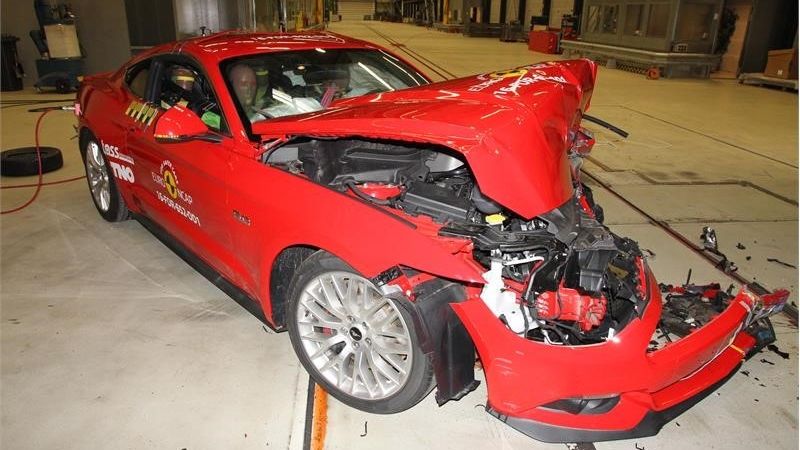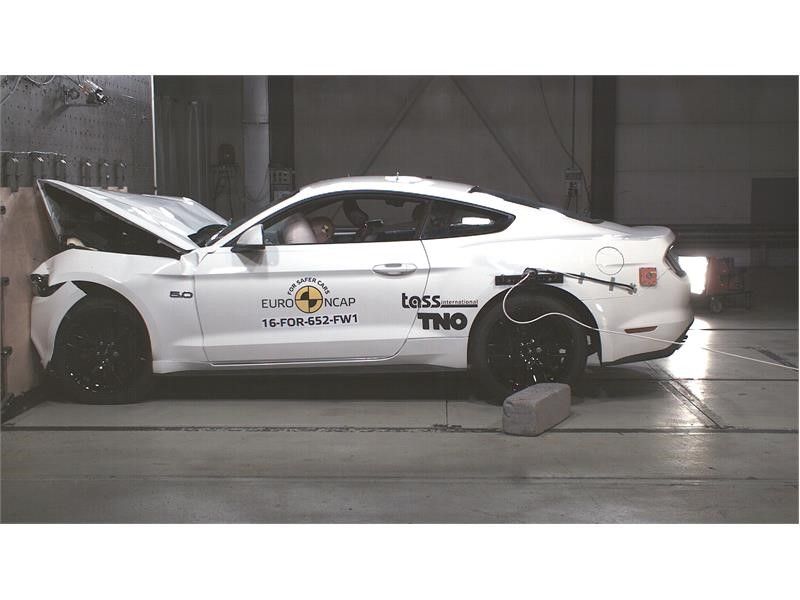The facelifted Ford Mustang did pretty well here in the U.S. when the IIHS put it through the paces at its crash test facility. It scored “Acceptable” in small overlap testing, and “Good” it moderate overlap, side collision, roof strength, and head restraints and seats testing. But, Ford fans over in Europe are stuck with the pre-facelifted model for a bit longer, as it didn’t perform all that well in Euro NCAP’s crash testing, scoring just two stars out of five when everything was said and done. In fact, out of the 15 cars recently tested by NCAP, including models like the Volvo V90 and S90 duo, the Audi Q2, Hyundai Ioniq, Suzuki Ignis, and even the SsangYong Tivoli, the 2016 Mustang was the absolute weakest link.
Now, before we get into the results, I want to make note that the Euro version of the Mustang doesn’t have all of the same equipment that’s found on the U.S. version, including things like seatbelt pre-tensioners and load limiters in the rear and a Forward Collision Warning system, among others, so that two-star rating isn’t completely representative of how safe the Mustang is, but it’s troubling nonetheless. Where the Mustang really failed was in relation to rear passengers, where the lack of pretensioners and load limiters play a huge role. In full-width frontal testing, rear test dummies showed significant potential for injury to the upper body, and thighs. Rear seat dummies also showed a high possibility of whiplash during a rear impact. Rear sitting children also have the potential for head injury during lateral impact and torso injury during frontal impact.
Front seat passengers saw mixed ratings during the Frontal Offset Deformable Barrier testing with the driver having adequate protection over most of their body, with the neck and thigh protection rated as good. The front passenger saw adequate protection for head and lower legs, while having good protection of the neck, torso, and thighs. During rear testing, front seat occupants received a marginal rating for whiplash protection. It should also be noted that the front driver and passenger airbags didn’t inflate properly on frontal offset testing, which also led to such a low rating. During the full-width front test, the rear passenger slid under the seat belt while the rear child dummy smacked his head on the interior trim during side impact crash testing.
Keep reading for the rest of the story
Ford Has a Chance to Make It Right
The two-star rating and data collected during NCAP testing do tarnish the Mustang’s reputation in current form, but the facelifted model should be hitting dealers toward the end of 2017, in which Ford can rectify most of these problems. With that model, it will receive pre-collision assist and lane keep assist as standard equipment, and you can bet Ford will throw in those rear pretensioners and load limiters as well. Ford has since to NCAP that the facelifted model will be available for testing later this year, but NCAP’s Secretary General, Michiel van Ratingen, is still a bit skeptical:
So, for now, it’s probably best for those of you living in Europe to wait for the facelifted model before getting yourself a new Pony car. But, then again, if you don’t plan on throwing your little ones in the back seat, the poor rating isn’t nearly as important to maybe you won’t mind the two-star rating. Either way, the poor rating will likely affect sales going forward, and if Ford doesn’t step up its safety game for the Euro-spec Mustang, it could be bad news for the blue oval. On that note, it’s probably best that you Mustang owners in Europe avoid car meets – we all know how that turns out, and you don’t exactly have the safest car on the road these days.
Current Drivetrain Specifications
|
Type |
3.7-liter Ti-VCT V6 |
2.3-liter EcoBoost I4 |
5.0-liter Ti-VCT V8 |
|
Configuration |
Aluminum block and heads |
Aluminum block and head |
Aluminum block and heads |
|
Intake manifold |
Composite shell-welded with runner pack |
Composite shell-welded with runner pack |
Composite shell-welded with runner pack and charge motion control valves |
|
Exhaust manifold |
Cast iron |
Three-port integrated into aluminum head |
Stainless steel tubular headers |
|
Valvetrain |
DOHC, four valves per cylinder, twin independent variable camshaft timing |
DOHC, four valves per cylinder, twin independent variable camshaft timing |
DOHC, four valves per cylinder, twin independent variable camshaft timing |
|
Bore x stroke |
3.76 x 3.41 in./ 95.5 x 86.7 mm |
3.45 x 3.7 in./ 87.55 x 94 mm |
3.63 x 3.65 in./ 92.2 x 92.7 mm |
|
Displacement |
227 cu. in./3,727 cc |
140 cu. in./2,300 cc |
302 cu. in./4,951 cc |
|
Compression ratio |
10.5:1 |
9.5:1 |
11.0:1 |
|
Horsepower |
300 HP @ 6,500 RPM |
310 HP @ 5,500 RPM |
435 HP @ 6,500 RPM |
|
Torque |
280 LB-FT @ 4,000 rpm |
320 LB-FT @ 2,500-4,500 rpm |
400 LB-FT @ 4,250 RPM |




